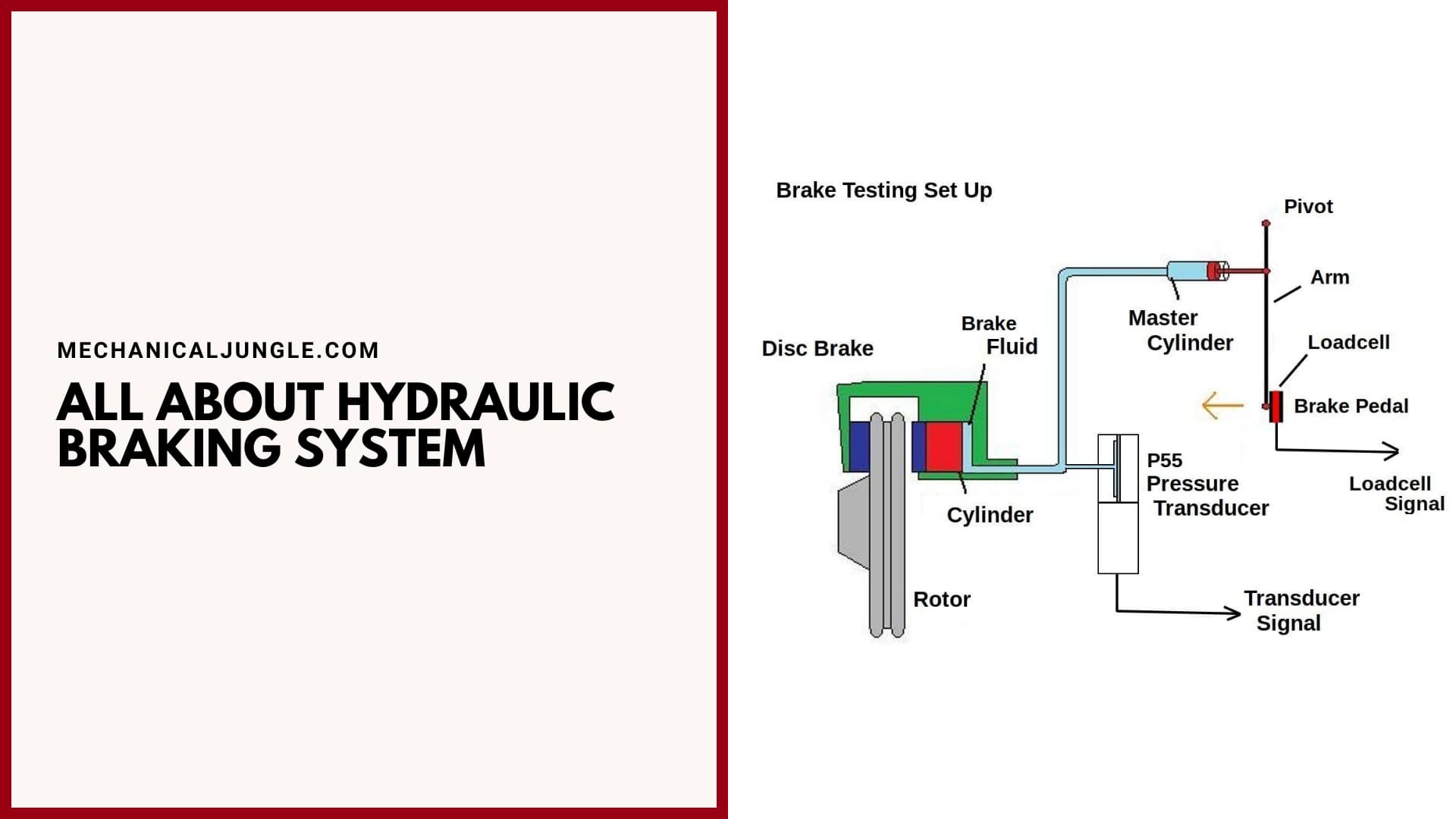
What Is Hydraulic Braking System?
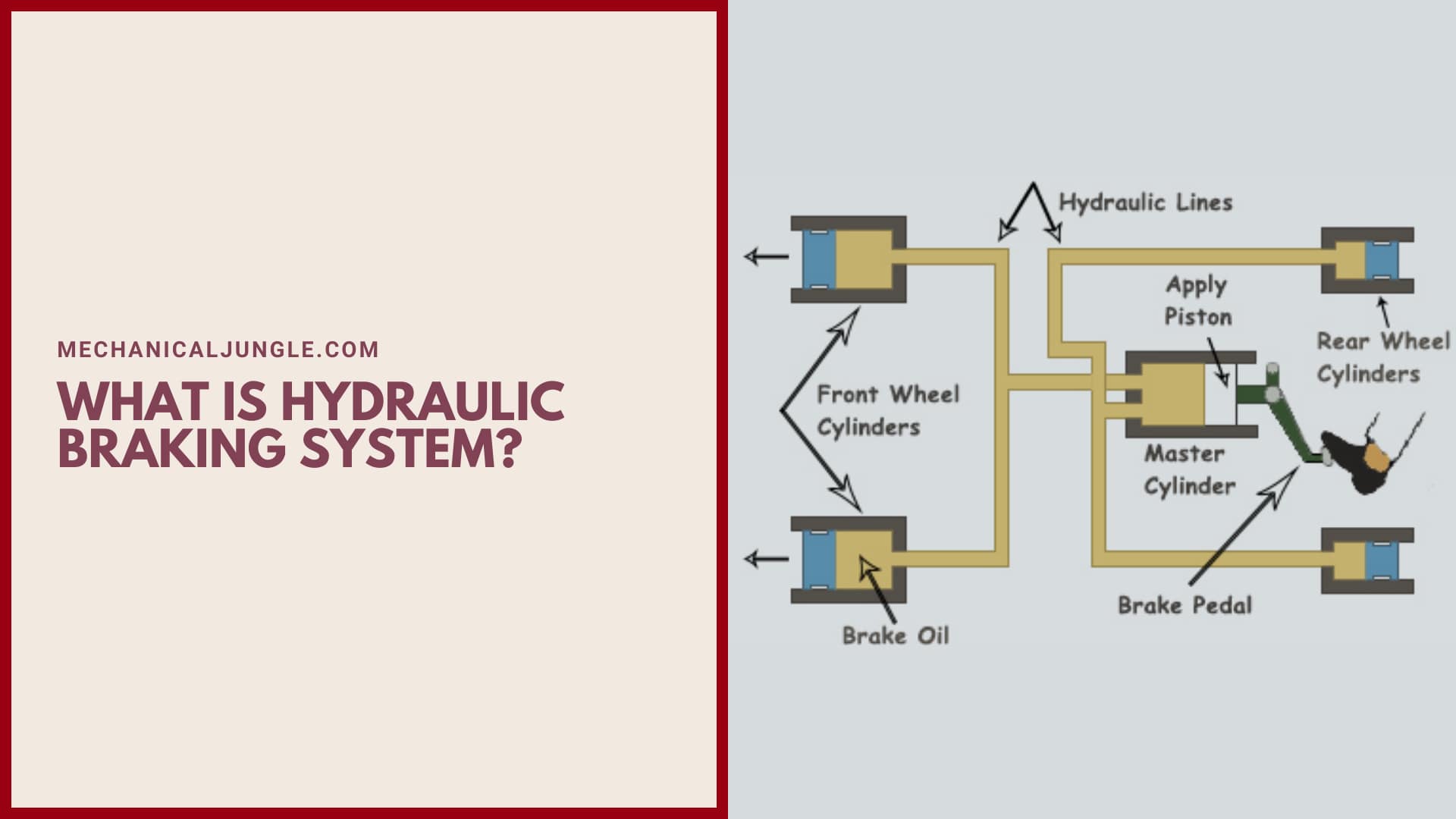
A hydraulic brakes system is a braking mechanism that uses brake fluid to transmit force into the system. The fluid transfers pressure from the control mechanism to the braking mechanism.
Hydraulic braking systems are widely used in low-speed four-wheelers such as the Tata Ace. It works with the drum type, while the disc type is used in almost all cars.
It is also used on some bikes. Single-acting hydraulic sacks are used in some Pulsar front-wheel brakes, while dual-acting hydraulic brakes are used in almost all situations described above.
In thises type of braking system, the mechanical forces transmitted by the driver on the brake pedal are converted to hydraulic pressure by a device known as a master cylinder (see article on the master cylinder), and then this hydraulic pressure is sent to the final drum or disc.
It goes to stop or accelerate the caliper vehicle. The hydraulic brakes are a type of braking system widely used in automobiles with the application of hydraulic fluid.
The working principle of hydraulic braking systems is based entirely on Pascal’s law, which states that the intensity of pressure inside a system closed by a liquid is always the same in all directions.
A good and efficient braking system is an essential part of a system running like automobiles & machines. Generally, in automobiles, different types of braking system are used as per the requirement as each type of braking system has its own applications and advantages.
Construction of Hydraulic Braking System:
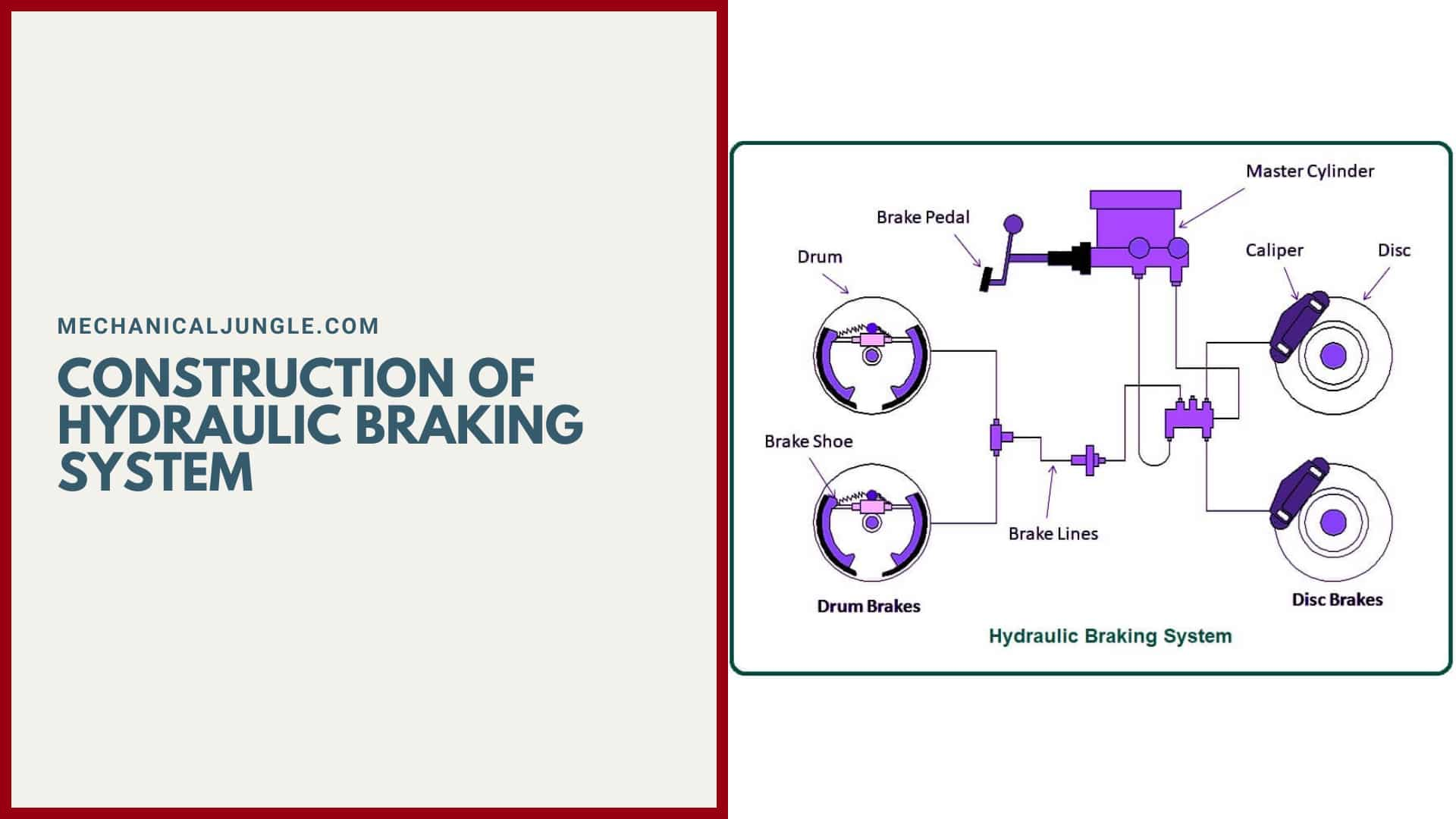
The construction of hydraulic braking systems involves the following part arrangement. Brake pedal or level, a wreath, also known as an actuating rod, a master cylinder assembly is carrying a piston assembly.
It is composed of one or two pistons, a return spring, a series of gasket or O rings, and a fluid reservoir.
The construction of hydraulic braking systems consists of reinforced hydraulic lines, & the brake caliper assembly consists of one or two hollows aluminum or chrome-plated steels piston. This is known as the caliper piston.
A thermally conductive brake is a set of pads and rotors, also known as a brake disc or drum attached to an axle.
A glycol-ether-based brake fluid filled the system to force the four wheels. However, other liquids may also be employed. Suddenly, manufacturers start designing passenger vehicles with drum brakes on four wheels.
Traditionally, disc brakes are used in the front wheel, while drum brakes are employed for the rear wheel. Disc brakes have better heat dissipation & greater resistance to fading and are safer than drum brakes.
This is why four-wheel disc brakes have increased significantly over the year. In addition, hydraulic brake pedals provide faster and more consistent pad return upon release.
Parts of Hydraulic Braking System:
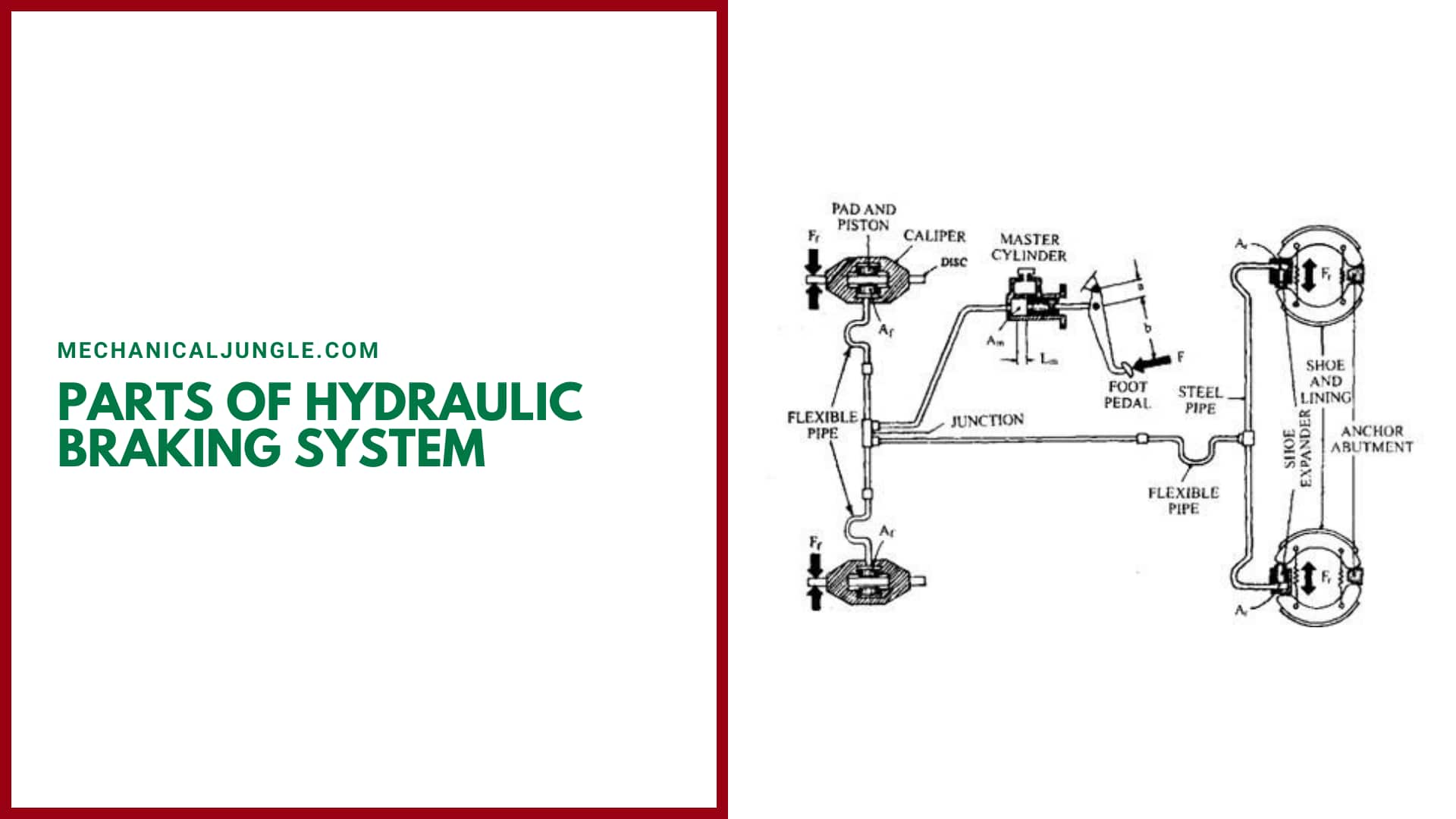
#1. Master Cylinder
It is the main part of the entire assembly. It acts as a hydraulic actuator with a piston-cylinder arrangement. It is responsible for converting mechanical force into hydraulic force.
Fluid is compressed and pressurized into the master cylinder as a brake pedal that is transmitted to the brake assembly via hydraulic lines.
#2. Brake Pedal and Mechanical Linkage
The brake pedal acts as the input of the master cylinder, or we can say that the entire assembly will start working when the brake pedal is pressed. It is manually pressed when we have to stop or slow down the running body.
It is connected with a small mechanical contact such as a spring that helps retract the pedal and further connects to the master cylinder. After the execution of the brake pedal, the master cylinder comes in handy.
#3. Hydraulic/Brake Fluid Reservoir
It is like a small tank for braking fluid. It is directly connected to the master cylinder for proper handling of hydraulic braking. It is necessary to maintain the exact amount of braking fluid throughout the assembly.
Sometimes due to small leaks, the fluid level goes down into the master cylinder, so a reservoir is needed to maintain the proper amount of brake fluid in the working operation. Braking fluid moves from the reservoir to the master cylinder when needed.
#4. Hydraulic Lines
Hydraulic lines are the relationships between the various components of a braking system. Braking fluid passes through these lines from the master cylinder to the brake. These are small diameter pipes that replace various types of mechanical linkage in the case of mechanical brakes.
#5. Brake Calipers
In the case of brake brakes, brake calipers are parts of the braking system that performs the brakes. Inside the brake calipers, pistons are placed, which are responsible for braking. Brake pads are also attached to pistons.
Calipers are placed on the circumference of the disc. The disc brake is an externally applied braking system. A disc is placed between the calipers.
#6. Drum Cylinder
A drum cylinder is a type of small cylinder that is used in drum brakes, and the brake is located inside the drum and is connected to both brake shoes. The drum brake is an internally applied brake.
Working of Hydraulic Braking System:

The work of the hydraulic braking system is very simple. To execute the brakes, we have two types of components: a disc brake and a drum brake.
The initial work is the same for both types, but the execution technique is different. Disc brakes are externally applied brakes through the brake calipers and discs, while drum brakes are applied internally through brake shoes and brake drums.
The working of both the types is as follows:-
#1. Drum Hydraulic Brake
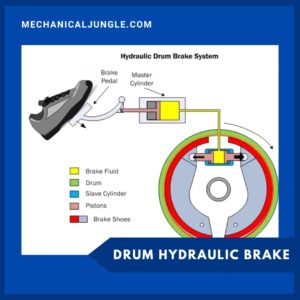
The following process occurs when the driver applies a brake in a vehicle equipped with hydraulic brakes mounted on the drum.
The speed or activation of the brake pedal causes a master cylinder to move a rod connected between the pedal and the piston, which in turn pushes the piston of the master cylinder inside the master cylinder like a medical syringe.
This movement of the pistons inside the master cylinders causes compression of the brake fluid inside the master cylinder, which in turn converts mechanical energy to hydraulic pressure.
Thises highly compressed brake fluid from the master cylinders moves inside the brake, and this hydraulic pressure transfers from the master cylinder to the brake drum.
When this high-pressure brake fluid o enters the wheel cylinder or drum cylinder due to its high pressure, there is movement in the cylinder piston, which in turn expands the static brake shoe attached to it.
Due to the expansion of the brake shoe, a friction contact is formed between the brake shoes and the drum lining (rotating drum part), which in turn converts the kinetic energy of the vehicle into heat energy & finally braking.
Single-acting drum-type braking – Single-acting drum type hydraulic brakes work exactly as stated above; this type of braking provides braking force in the single wheel or single pair.
Double Acting Drum Type Braking – High-pressure brake fluid from the master cylinder in double-acting hydraulic brakes is divided into two directions, i.e., all wheels of bikes and all wheels of cars, due to the use of tandems master cylinders (article on master cylinder).
#2. Disc Hydraulic Brakes

The process involved is similar to that of a drum drum when the driver brakes a vehicle equipped with a disc-type hydraulic brake when the high-pressure brake fluid enters the brake lines but is slightly different thereafter – High-pressure brake fluid from the brake lines enters the disc caliper cylinder of the disc brake system.
This high-pressure brake fluid causes motion in the piston of the caliper cylinder, which in turn causes the speed of the brake pads attached to the piston inside the caliper.
Due to this movement of the brake pads, there is the clamping of the rotating disc rotor, and due to this frictionless contact between the brake pads and the rotating disc rotor, the kinetic energy of the vehicles are converted into heat energy, which in turn would be stopped, or de is. Accelerate the vehicle.
Single Acting Disc Type Braking – The function of single-acting disc type hydraulic braking is exactly the same as mentioned above; this type of braking provides a single braking force in the single wheel or single pair wheels.
Double-acting disc type braking – In a double-acting disc type hydraulic brake, high-pressure brake fluid is delivered in 2 directions from the master cylinder, that is, due to the use of tandem master cylinders in both wheels and bikes in all wheels.
Application of Hydraulic Braking System:
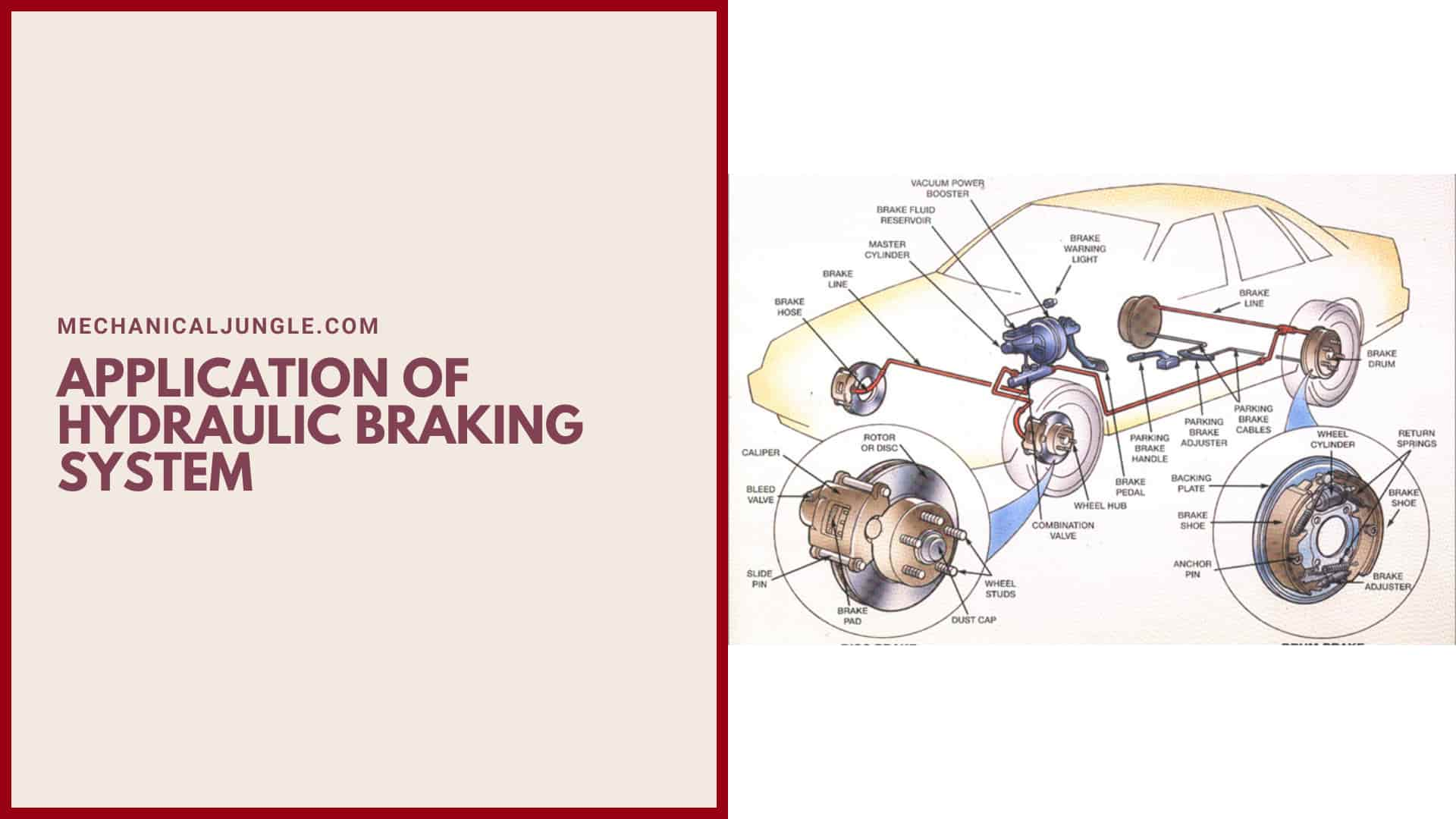
- Drum type hydraulic brakes – They are used in some low-speed four-wheel vehicles such as Tata Ace.
- Disc Type Hydraulic Brakes – They are used in almost all cars like Maruti Suzuki Swift, Hyundai i20, etc., & also in bikes like Bajaj Pulsar 180, KTM Duke 390, etc.
- Single-acting hydraulic brake – Pulsar 180 front brakes are of single-acting type.
- Dual Acting Hydraulic Brakes – All of the above cars.
Frequently Asked Questions (FAQ)
What Is a Hydraulic Braking System?
A hydraulic braking system is a braking mechanism that uses brake fluid to transfer force from the brake pedal to the braking mechanism, effectively stopping or slowing down a vehicle.
How Does a Hydraulic Braking System Work?
The system works based on Pascal’s law, where the mechanical force applied to the brake pedal is converted into hydraulic pressure by the master cylinder. This hydraulic pressure is transmitted through brake lines to either drum or disc brakes to create friction and slow down the vehicle.
What Are the Main Components of a Hydraulic Braking System?
Key components include the master cylinder, brake pedal, hydraulic fluid reservoir, hydraulic lines, brake calipers (for disc brakes), and drum cylinders (for drum brakes).
What Is the Difference Between Drum and Disc Hydraulic Brakes?
Drum brakes use brake shoes that press against a rotating drum, while disc brakes use brake pads that clamp onto a rotating disc. Disc brakes generally offer better heat dissipation and braking performance compared to drum brakes.
What Types of Hydraulic Brakes Are Commonly Used in Vehicles?
Hydraulic braking systems can be drum-type or disc-type. Disc brakes are often used in modern vehicles due to their superior performance, while drum brakes are sometimes found in older or low-speed vehicles.
What Is the Role of the Master Cylinder in a Hydraulic Braking System?
The master cylinder converts the mechanical force from the brake pedal into hydraulic pressure, which is then transmitted through the brake lines to the braking mechanisms.
How Is Brake Fluid Used in a Hydraulic Braking System?
Brake fluid is essential for transmitting the hydraulic pressure within the braking system. It moves through hydraulic lines to actuate the brake calipers or drum cylinders, enabling the braking process.
What Maintenance Is Required for Hydraulic Braking Systems?
Regular maintenance includes checking and topping up brake fluid levels, inspecting hydraulic lines for leaks, and ensuring brake pads and shoes are in good condition. It’s also important to bleed the brakes periodically to remove any air from the system.
Can Hydraulic Braking Systems Fail?
Yes, hydraulic braking systems can fail due to issues like leaks in the brake lines, contamination of brake fluid, or wear and tear on components. Regular maintenance and timely repairs are crucial to prevent failure.
What Are Single-Acting and Double-Acting Hydraulic Brakes?
Single-acting hydraulic brakes apply braking force in one direction, typically used for individual wheels or pairs. Double-acting hydraulic brakes distribute force to multiple wheels or brake pairs, providing balanced braking across the vehicle.

